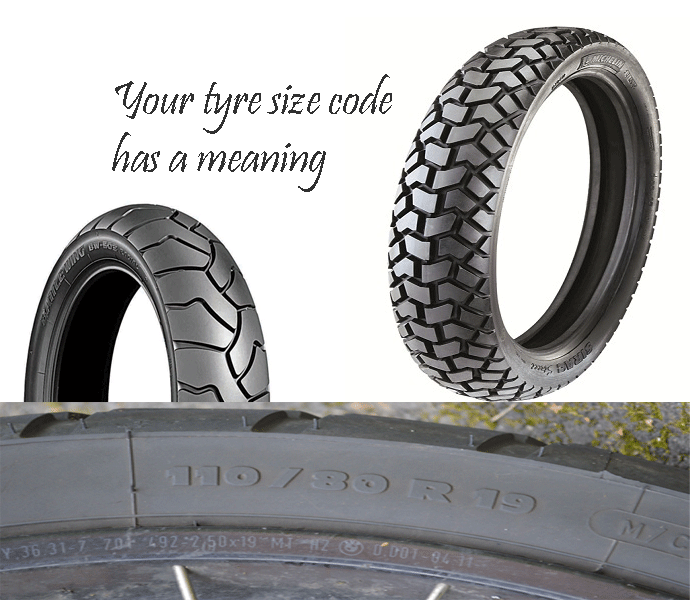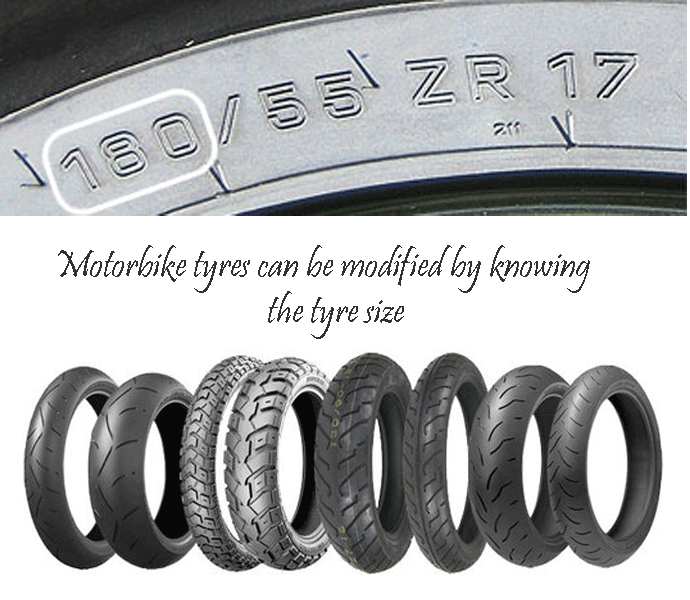What does your Motorbike’s tyre size code mean?
Last updated on – 23rd January, 2016
Ever noticed, what does the components of tyre size mean? The abbreviations written in alphanumeric form is a matter to stare. While changing the tyres, most of the people never look at the sizes of their wheel. They handover the job completely to the tyre store caretaker and pay the related bills. This is acceptable at branded manufacturer’s outlet, but one must know about the sizes if they going to purchase a tyre from some retail store and/or thinking of modifying the tyre sizes.
This post will make you aware about the same and by the end of this article, you will be able to judge how tyres can be selected for your motorbike. The tyre sizes are assigned in many different ways. Consider the following size.
155/65 R14 65 S
Now so many numbers and few alphabet are there, which may produce confusion. Here these things are simplified.
155 (tyre width)
The first number in the tyre size decides the width. The width is measured in millimeters. This is also known as nominal section width. It is measured from one wall to another. It depends upon the bike’s specification. Higher width helps in maintaining higher grip on the road and meant for high performance bikes.
Read Also: Benefits of Alloy Wheels and Tubeless Tyres
65(Aspect Ratio)
The second number describes the aspect ratio. This is concerned with the height of the side walls of the tyre. The aspect ratio is not measured in any unit, rather, it is the percentage of width. 65 aspect ratio means that the wall height of tyre is 65% of its width.
R (Tyre type)
This is the type of tyre’s construction base. Here, “R” denotes “Radial tyre” type construction. It sometimes also gets denoted by “B” which means “belted”. It depends upon the company’s internal issues and their technology.
14 (Rim Size)
This number denotes the internal diameter of the tyre. It is measured from one side to another following the center of the wheel. Each motorbike manufacturer has constructed their product, concerning a definite wheel size which will balance the whole geometry of the bike.
65 (Load Index)
The load index is coded number which decides the maximum amount of load which the tyre can sustain. It also depends upon the tyre’s geometry and area of application for which it is going to be used. Here, as it is a coded number, 65 relates to 290KG of maximum weight which this tyre can bear. Different coded numbers have different loading capacity.
T (Speed Symbol)
The last alphabet here shows the amount of maximum speed over which a tyre can run efficiently. The “T” here is a coded letter which has a value of 190 KM/H. It can be varied from bike to bike. There are many other coded letters also which have encrypted a maximum speed for that tyre.
Apart from the above tyre size, many other kind of sizes are also in circulation around the world. Few of their examples are mentioned below.
- 110 / 70 ZR 17 M/C (54W) TL
- 130 / 90 -18 69 R TT
- 2.75 -21 45 L TT
- M T 90 B 16 74 H TL/TTv
In above examples, some new characters have also been included. You can refer to them in following content.
TT and TL: This abbreviation mentions the type of tyre. The “TT” refers to the tube type. These kind of tyres contain a rubber tube which collects the air at a particular pressure. TL refers to the tubeless tyres, which do not have any tube, rather, they are better than the tube type tyres during punctures.
2.75 (section width): The section width is the width of tyre. Here it is mentioned in inches and the same is mentioned in millimeters in the first point.
Read Also: Bike on Broad Tyres: Will it only effect Mileage?
I hope you will feel comfortable while switching of modifying your motorbike’s tyre size. But one must be aware of that, modifying the tyre size will ultimately affect the performance of your tyre; abruptly or friendly, it depends.
What does your Motorbike’s tyre size code mean?
http://www.blog.sagmart.com/wp-content/uploads/2015/07/tyre-size-code-simplified-2-300x300.gif Bikes Reviews and TipsLast updated on – 23rd January, 2016
Ever noticed, what does the components of tyre size mean? The abbreviations written in alphanumeric form is a matter to stare. While changing the tyres, most of the people never look at the sizes of their wheel. They handover the job completely to the tyre store caretaker and pay the related bills. This is acceptable at branded manufacturer’s outlet, but one must know about the sizes if they going to purchase a tyre from some retail store and/or thinking of modifying the tyre sizes.
This post will make you aware about the same and by the end of this article, you will be able to judge how tyres can be selected for your motorbike. The tyre sizes are assigned in many different ways. Consider the following size.
155/65 R14 65 S
Now so many numbers and few alphabet are there, which may produce confusion. Here these things are simplified.
155 (tyre width)
The first number in the tyre size decides the width. The width is measured in millimeters. This is also known as nominal section width. It is measured from one wall to another. It depends upon the bike’s specification. Higher width helps in maintaining higher grip on the road and meant for high performance bikes.
Read Also: Benefits of Alloy Wheels and Tubeless Tyres
65(Aspect Ratio)
The second number describes the aspect ratio. This is concerned with the height of the side walls of the tyre. The aspect ratio is not measured in any unit, rather, it is the percentage of width. 65 aspect ratio means that the wall height of tyre is 65% of its width.
R (Tyre type)
This is the type of tyre’s construction base. Here, “R” denotes “Radial tyre” type construction. It sometimes also gets denoted by “B” which means “belted”. It depends upon the company’s internal issues and their technology.
14 (Rim Size)
This number denotes the internal diameter of the tyre. It is measured from one side to another following the center of the wheel. Each motorbike manufacturer has constructed their product, concerning a definite wheel size which will balance the whole geometry of the bike.
65 (Load Index)
The load index is coded number which decides the maximum amount of load which the tyre can sustain. It also depends upon the tyre’s geometry and area of application for which it is going to be used. Here, as it is a coded number, 65 relates to 290KG of maximum weight which this tyre can bear. Different coded numbers have different loading capacity.
T (Speed Symbol)
The last alphabet here shows the amount of maximum speed over which a tyre can run efficiently. The “T” here is a coded letter which has a value of 190 KM/H. It can be varied from bike to bike. There are many other coded letters also which have encrypted a maximum speed for that tyre.
Apart from the above tyre size, many other kind of sizes are also in circulation around the world. Few of their examples are mentioned below.
- 110 / 70 ZR 17 M/C (54W) TL
- 130 / 90 -18 69 R TT
- 2.75 -21 45 L TT
- M T 90 B 16 74 H TL/TTv
In above examples, some new characters have also been included. You can refer to them in following content.
TT and TL: This abbreviation mentions the type of tyre. The “TT” refers to the tube type. These kind of tyres contain a rubber tube which collects the air at a particular pressure. TL refers to the tubeless tyres, which do not have any tube, rather, they are better than the tube type tyres during punctures.
2.75 (section width): The section width is the width of tyre. Here it is mentioned in inches and the same is mentioned in millimeters in the first point.
Read Also: Bike on Broad Tyres: Will it only effect Mileage?
I hope you will feel comfortable while switching of modifying your motorbike’s tyre size. But one must be aware of that, modifying the tyre size will ultimately affect the performance of your tyre; abruptly or friendly, it depends.



Leave a Reply